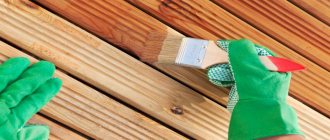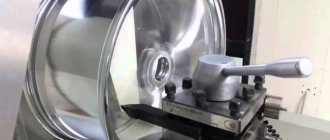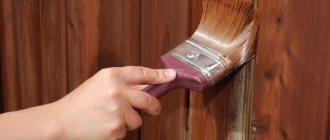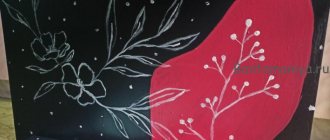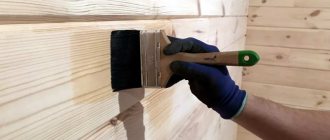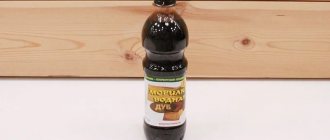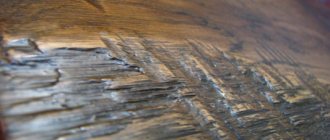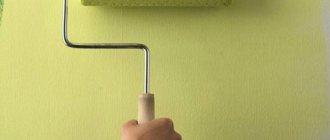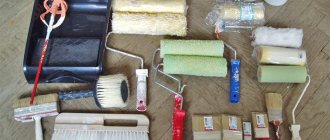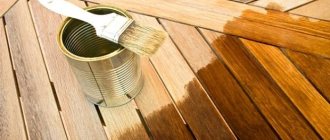Beitz is not just one type of coloring composition. This is a product that breathes life into old furniture, stairs, floors, doors and window sills that have long lost their presentable appearance. From this article you can find out what tinting abilities wood stain has: colors used to create an exotic interior, shades that imitate expensive species, as well as interesting combinations that allow you to achieve beautiful effects.
Stain is a tinting mixture that can be used to give any wood product the desired shade.
How to age wood with vinegar?
The infusion of table vinegar and steel wool soaks into the wood and draws out tannins (tannins), giving yellow pine the grayish hue of old, faded wood. Due to the deep penetration of the solution, the surface can be lightly sanded after treatment. The solution also dries out the wood.
Interesting materials:
How much does a ticket to the Erarta Museum cost? How much does Bicilin cost? How much does it cost to keep a body in the morgue? How much does Durex cost 12 pieces? How much does a house cost in Skyrim? How much does delivery cost from Shein? How much does a tour to Luxor from Hurghada cost? How much does the original Gelik cost? How much does a talking parrot cost in Ukraine? How much does a gram of 750 gold cost in Ukraine?
Wood stain: varieties and their features
The basis for the production of liquid impregnation can be water, alcohol, or oil. And each variety has its own characteristics.
Water stain is available in the form of a water-soluble powder mixture and a ready-to-use mixture. This stain, the second name for stain, is in greatest demand. It can be used for both interior and exterior work.
Powdered stain dissolves well in water. It is environmentally friendly and has elasticity and adhesion. The diverse palette of shades begins with the lightest tone and ends with dark red.
Various shades of stain colors
But there are several disadvantages. First, it is not advisable to use liquid impregnation for resinous rocks. Spots may appear on the surface of the wood. And secondly, by painting a wooden surface with a water-based stain, the wood fibers are raised. The positive thing is that the structure of the wood is more emphasized and at the same time it becomes more susceptible to the influence of moisture.
To eliminate this phenomenon, the surface of the wooden product must be wetted and left for some time. The wood is then sanded and covered with a water-based stain.
Choosing stain color
Alcohol based stain is an aniline dye dissolved in denatured alcohol. It also comes in ready-made and powder form.
The dyes are quickly absorbed into the wood fibers and after half an hour the paint is completely dry.
Uniform painting with stain by hand is unlikely to work, since the alcohol evaporates immediately after application. Thus, stains may appear, so it is better to use a spray gun.
Varieties of stains
Oil stain can color a wooden product in a color known to the human eye. Pigment stain gives wood a uniform color and hides the texture. The impregnating liquid colors the wood from the inside and emphasizes the structure.
Oil-based stain does not dry as quickly as alcohol-based stain, but it is very convenient to work with. It is applied in an even layer and does not lift the fibers, and does not form a film on the surface, which allows the wood to breathe.
Dilute the liquid with white spirit solvent.
Wax and acrylic stains have the same qualities as the tinting materials described above. In addition, wax stain is used to restore the old coating. It paints over small differences in surface color.
These wood stains cover the surface of the wood with a layer that protects it from moisture. It's easy to check. It is enough to pour a small amount of water on the floor, and it will scatter drop by drop. At the same time, the protective film of wax stain is vulnerable to mechanical stress and needs protection. To do this, it is coated with varnish.
Water-based stain in bleached oak color, topped with wax
Acrylic and wax liquids have a rich palette of colors and emphasize the wood texture, which is why they are also called rustic.
Return to content
DIY stain
You can make your own toning liquid at home without using expensive ingredients using plants, coffee and chemical ingredients.
Stains based on plant components
Light wood is given a red tone using onion peels. It is necessary to prepare a strong decoction from it, which is applied to a wooden surface. You can add the decoction to brown beans.
Products made from birch, coated with a decoction of larch bark, will take on a red tint.
The walnut solution will stain the wood brown. Slightly rotten nut shells must be dried in a dark place. And after that it should be ground into powder and made a decoction. The finished broth needs to be filtered and soda added.
How to make stain from walnut shells
After painting the wood with walnut mortar, the surface can be further treated. For example, potassium dichromate diluted in water will give the wood a red tint. A gray tint will be obtained if you paint the wood with diluted vinegar.
The brown color will be more beautiful if you mix nut shell powder with ground willow and oak bark, as well as alder catkins. These components must be mixed with 1 tsp. baking soda, add water and cook over low heat for a few minutes. The stain you make yourself must cool, and then you need to strain it. Instead of nut shells, you can use oak or apple bark.
An infusion of buckthorn fruits, especially unripe ones, will give the tree a yellow tint, and added alum will enhance it.
The bark of trees, such as oak or alder, can tint a wooden surface black.
Stains from tea, coffee and vinegar
Tea contains the component theanine, which perfectly colors the wood in various shades, which is influenced by the concentration of the brew.
Ground coffee beans mixed with baking soda also tint wood products in different colors. And a strong concentration of instant coffee is used instead of stain.
A vinegar solution will give the wood a red tint. In glass containers, degreased metal parts, such as nails, are filled with acetic acid.
The nails are infused for 1-7 days in a darkened room. The more they are in the acid, the richer the color will be. Wood tinting must be done outdoors or in a well-ventilated area. It's just that the vinegar mixture has a pungent odor.
A vinegar-based DIY wood stain can turn ordinary wood into ebony. It is enough to add highly concentrated theanine (oak or walnut bark) to it, which will paint the tree anthracite black.
Oak bark as a raw material for making stain
The tree will become cherry-colored from potassium permanganate or, in common parlance, potassium permanganate. It should be diluted in warm water. The basic proportion is 50 g of potassium permanganate per liter of water, but it can be varied to achieve a dark brown color, close to black. Do-it-yourself stain is applied with a brush as soon as it is prepared. And after 5 minutes it should be wiped with a damp sponge. The wooden product can be re-processed if necessary.
It should be taken into account that potassium permanganate fades, so it must be covered with protective solutions.
Contains chemicals
The juice from wolfberries in combination with various acids can color the tree not only black, but also in different shades. If you add baking soda to the juice, the color will turn blue. Glaubert salt will give a scarlet tint, and copper sulfate will give a brown tint.
Oak and other woods with high levels of theanine can be toned to brown tones by covering them with slaked lime. A nut treated with lime will acquire a brownish-greenish tint.
There is another way to color wood using theanine. The wooden product must first be coated with a composition of 75 g of soda ash or 35 grams of carbonate dissolved in 1 liter. water. When the surface is dry, it is covered with a solution consisting of 50 grams of theanine and a liter of water. After an hour, the color of the stain will appear.
Yellow, brown and reddish shades
Light wood will acquire a yellowish tint if it is treated with a decoction of barberry root and 2% alum. Instead of barberry root, you can use poplar shoots. Then the color will become even more saturated. This decoction must be prepared a week before dyeing. It is prepared in this way: 150 g of poplar shoots must be boiled in a liter of water, then add alum and boil for another hour. The broth should be strained and allowed to brew. After a week you can use it.
The same decoction of poplar shoots will also give a green tint if you add a strong decoction of oak bark to it. The same effect is created by a mixture of vinegar with 60 grams of verdigris powder. The mixture is boiled for about 15 minutes and then covered with wood. Planed products will not immediately acquire the required shade. They should be soaked in the mixture.
In rare cases, the wood should be gray in color. A similar effect can be achieved by mixing one part each of water and vinegar, and placing rusty nails or other small metal objects in this mixture. But first you need to give a little time for the mixture to infuse. And then dip the wood in stain and wait until it acquires the desired color.
If you want to get a darker tone of oak wood, use ammonia mixed with water. This DIY stain should not come into contact with mucous membranes or skin. Therefore, painting work should be carried out outdoors. It must be taken into account that the liquid quickly loses its properties, so the work must be fast. You can also make stain in small portions.
A small wooden product that can be placed in a tightly sealed glass or ceramic container. Place an open container with the mixture there. After a couple of hours, the product can be taken out.
When the wood is painted the desired color, the solution should be washed off.
Return to content
Ombre colors
Ombre is a type of gradient that does not imply a transition from color to color, but a transition from light to dark or vice versa. By the way, I have a detailed video. The ombre effect is often used in furniture decor, for example, to darken the edges of drawers, or to create a transition on the legs.
First, as in the first case, we do the usual staining. Then, after the paint has dried, we take a darker or, conversely, lighter in tone color and begin to paint the edge. It is very important not to leave a sharp border, so as you approach the center, the paint becomes more and more diluted, and the very bottom edge is simply washed away with clean water.
Depending on how much you want to lighten or darken the edge, you can apply several coats of paint or limit yourself to one or two. I decided to show what the ombre transition from all edges to the center would look like. I get a strictly rectangular gradient shape, but you can make it smoother, for example, round or oval.
Subtractive mixing method
This method of adding colors involves creating fewer tones than is possible using RGB. In theory, this model involves obtaining black color by mixing a number of other colors. But when the pigments are actually mixed, what comes out is not a black tone, but a dark brown one, with a brown tint, which will be very noticeable when diluted.
Therefore, in a printing house where the subtractive method is used, a key tone is added to this mixture - real black in finished form. No ink obtained by mixing colors can replace true black pigment, as printers have long known.
Gray maple.
In order to make a surface from any wood that is indistinguishable from gray maple , you need to immerse the wooden product in a solution of 50 grams of soap dissolved in 1 liter of clean water for 3-4 hours. Then the wood is washed with water, dried and placed for 1 hour in a 2% aqueous solution of iron nitrate Fe(NO3)3, washed again and dipped in a 2% soda solution. The last operation is keeping in an indigo carmine solution containing 12.5 g of this dye in 1 liter of water. As a result, the wooden product acquires a gray color with a bluish tint.
How can you give wood a brown tint? So, if oak or any other species (for more information about types of wood, see this section) with a significant content of tannins (for example, tannin) is soaked in lime milk (this is what is called a suspension of slaked lime in water), then after drying and removing the plaque lime with a soft brush, the surface of the wood will become light brown. And treating the surface of oak wood in a 20% solution of iron sulfate after drying will give a dark brown color, treatment with ammonia will give a gray-brown color.
Application rules
Before applying the tinted varnish composition, it must be thoroughly mixed. The varnish can be applied using a spray gun, brush or roller, but you need to prepare the base in advance. All contaminants are removed from the base, including dust, dirt, old paints, grease stains, etc. As a result, the surface should be clean and dry.
After cleaning, the flooring material must be scraped or sanded. If a tinted type of varnish will be applied to a mineral material, then you must first prime such a surface using varnish diluted with water, one to one.
The composition is applied in two or three layers. Before applying each subsequent coating, the previous one must be completely dry. During operation, the varnish composition may thicken; it can be diluted in accordance with the instructions and stirred regularly, once every 20-30 minutes.
The tinted solution must be applied at air temperatures above 12 degrees. Immediately upon completion of work, all tools used must be washed with running water.
Surface treatment before work
In order for the wood stained to be uniform and beautiful, before covering the wood with stain it is necessary to prepare the surface. To do this you should:
1. Remove the old coating, if present, by sanding, which will not only clean the surface, but also level it.
2. Degrease the wood. Grease stains must be wiped with a sponge soaked in white spirit or gasoline.
3. Deresin conifers. The resin found in wood can cause stains and poor stain absorption. Thus, it must be treated with a special solution.
When preparing the surface, you may need to strip off old paint, so we recommend that you familiarize yourself with the most effective methods for removing it. It is worth noting that the natural dyes that were listed in the article above are also widely used in the production of mulch at home.
There are several ways to prepare a solution for degumming.
1. 50 g of potassium carbonate must be mixed with 60 g of soda ash and dissolved in a liter of water, the temperature of which is 60 degrees.
2. 50 g of caustic soda is dissolved in one liter of warm water. The result is a 5% soda solution, which should be used to treat the surface.
3. Add 250 g of acetone to 0.75 liters of purified water.
The finished mixture should be applied liberally to the surface of the wood. After half an hour, the wood should be wiped with a cotton cloth and rinsed with warm water.
Return to content
Multi-layer painting with holes. Using a metal scraper.
The next method is simple, but very effective for those who love aging techniques.
The first color is applied to the primed wood. I took gray linen. In this case, you can apply the color in one thick layer and use an old bristle brush, which leaves marks. I lightly dry the paint with a hairdryer, but not completely. I take a metal spatula and start peeling off the paint.
In those places where it has not dried out, it is very well removed in whole layers. The next color is sage. I apply it randomly, making strokes in different directions. I dry it again and peel it off with a spatula. In some places you can apply force and even scratch the soil right up to the wood.
Conclusion
I would also like to remind you that the final shade of a wooden product takes on only after complete drying and if stable temperature conditions are maintained in the room. In cases where humidity fluctuates greatly, an additional deviation from the desired result is possible - the tone may be darker (read also the article “Wax coating for wood: compositions. Preparation and application”).
In the video presented in this article you will find additional information on this topic.
Technology of imitation mahogany at home.
To paint a wooden surface with imitation mahogany, you need to boil 5 grams of carminic acid in 100 ml of water for 3 hours and then cool the resulting chemical solution. Then the thoroughly polished surface of ordinary wood is brushed several times with this solution, and the already dried surface is treated with a solution containing 6 grams of tin chloride (SnCl2) and 3 grams of tartaric acid in 100 ml of water.
As a stain, you can use any solution of cherry-red dye (for example, for fabric), and use it to achieve the desired shade by applying the solution to the surface of the wood in several stages.
